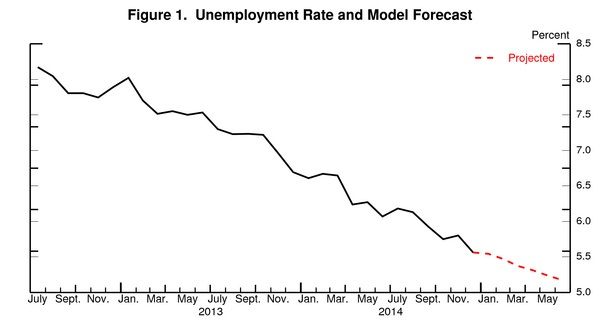This post discusses my monthly update of the Barnichon-Nekarda model. For an introduction to the basic concepts used in this post, read my introductory post (Full details are available here.)
In December, the unemployment rate declined to 5.6%, 0.2% lower than I expected. The difference owes to a stronger than expected labor market with a stronger than expected increase in workers’ job finding rate and to a stronger than expected decrease in workers’ job separation rate (layoffs). This faster than anticipated decline in unemployment over the recent months led our model into revising its outlook: The model now expects to unemployment to decline over the next 6 months with a rate at 5.5% by January and reaching 5.2% by June.

This model’s forecast can be easily understood by looking at the projected behavior of the “steady-state” unemployment rate. The steady-state unemployment rate, the rate of unemployment implied by the underlying labor force flows—the blue line in figure 2— stands currently at 5.2%, 0.4% lower than the actual unemployment rate. Our research shows that the actual unemployment rate converges toward this steady state. With a steady-state unemployment rate substantially lower than the actual rate, this “steady-state convergence dynamic” will push the unemployment rate down, implying a decline in unemployment going forward.

To forecast the behavior of steady-state unemployment, the model propagates forward its best estimate of how the flows in and out of unemployment will evolve over time. The big change in the model’s forecast is the anticipated behavior of the job finding rate (figure 4). Following faster than expected increases in the job finding rate as well as readings for leading indicators (such as improvement on the job openings front), the model now expects steady improvements in the job finding rate going forward. Importantly, with a job finding rate still substantially below its pre-recession level, figure 4 suggests that there still is a lot of room for more unemployment decline: According to the model projection, by mid-2015, when the unemployment rate stands at 5.2%, the job finding rate will still be 10 percent below its pre-recession level.



To read more about the underlying model and the evidence that it outperforms other unemployment rate forecasts, see Barnichon and Nekarda (2012).
The Brookings Institution is committed to quality, independence, and impact.
We are supported by a diverse array of funders. In line with our values and policies, each Brookings publication represents the sole views of its author(s).




Commentary
Unemployment To Continue To Drop, Hitting 5.2 Percent by June
February 5, 2015